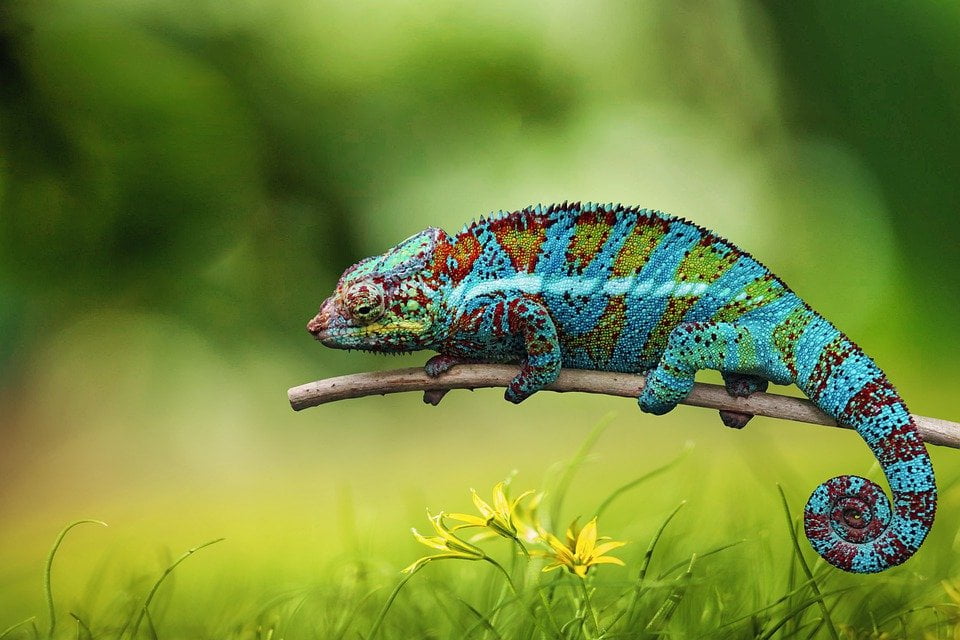There is an opinion that a chameleon takes on the color of the surface it is on in order to become more invisible. We decided to check whether this reptile really has such an outstanding camouflage ability.
They write about the ability of chameleons to change color for camouflage purposes sites And blogs, and the owners of these lizards post video with your colorful pets. The idea that a chameleon can adapt to its environment has also entered everyday language - a person who is ready to adapt to any circumstances called “chameleon”, A.P. Chekhov even has a name of the same name story. Still in Ozhegov’s dictionary indicated, that a chameleon is a lizard that “changes its color with color changes in its environment.” Wardrobe items that can change their color are also called chameleons, for example chameleon glasses. The famous brand Ray-Ban even removed clip, which quickly became viral, about how an animal changes its color when crawling from pink to green glasses.
Chameleons have been described since Antiquity. Thus, the ancient Greek philosopher Aristotle in “The History of Animals” indicatedthat the lizard is capable of changing its color, and the ancient Roman scientist Pliny the Elder associated these changes with the background surrounding the animal. Besides this, he wrote about the chameleon: “He is the only animal that maintains its life not by eating and drinking or anything else, but by food obtained from the air, in a terrifying way, but completely harmlessly, by opening its mouth.” In fact, the chameleon catches insects at such a speed that it was only possible to record it using slow motion technology. Plutarch was one of the first to compare the changeable character of a person with the ability of this lizard to change color. About the ancient Greek politician Alcibiades he wrote: “Among his many abilities, they say, was the art of catching people in his networks, adapting to other people’s customs and orders. With the speed of his transformations, he left even a chameleon behind: besides, a chameleon, as they say, is capable of taking on any color except white, while Alcibiades, whether he saw good examples or bad ones around, imitated both with equal ease.”

Today there are about 90 species of this reptile. Chameleons live primarily in Africa, especially on the island of Madagascar and neighboring ones, but some species are found in Spain, the southern islands of the Mediterranean, the Middle East, and also in Southeast Asia. At the same time, chameleons are one of the most easily tamed reptiles, because having grown up with people, they finds out owners and easily makes contact, is able to stay in a person’s arms for a long time, and also carefully eat from the hand or from special soft tweezers, with which the owner can hold the prey, simulating hunting for the animal.
Two types of cells are responsible for changing the color of a chameleon: chromatophores and iridophores. Having many branches chromatophores are located in the outer and deeper layers of his skin and contain grains of pigments of black, red, yellow and dark brown colors. When these processes contract, the pigments are redistributed, changing the color of the animal. Iridophores Due to the transformation of the skin structure, they are able to bend and reflect certain waves.
In 2008, Australian scientists started Observation of male Bradypodion, a species of chameleon from South Africa. Using highly sensitive equipment, they measured the speed and intensity of the animals' color changes as they interacted. The chameleons showed the brightest and fastest “flares” during a duel. This continued until one, recognizing himself defeated, changed color to dark brown, which is what these lizards have means admitting defeat and asking “don’t hit me.” Also, according to scientists, the bright "flares" were so fast - just a few milliseconds - that potential predators in the wild would not have time to notice them.
At the same time, the change in color has not only a “dueling” purpose - shimmering with the colors of the rainbow, chameleons also lead courtship. The male demonstrates his interest in various shades, the female, in turn, taking one color or another, accepts or rejects his proposal. Thus, the main reason for the color change, scientists think still conveying emotions and moods. In addition to this, in 2016 a group of scientists noted the pattern between the color change of a chameleon and the surrounding temperature.

However, none of these experiments completely refuted the hypothesis of mimicry as another reason for color changes. For this purpose another observation — scientists compared the possible palette for each species and the prevailing colors of their habitat. If the camouflage hypothesis were correct, then lizards capable of displaying the maximum number of bright colors should live in places with the most colorful landscape and vice versa. However, no such pattern was found. At the same time, scientists admit that at some stage of evolution, the ability to change color in theory could serve the purpose of camouflage. Conducted owners animals experiments show: a placed chameleon does not take on the color of its environment, unlike, for example, flounder.
Thus, contrary to popular belief, the chameleon, by changing color, does not at all strive to become invisible. Quite the opposite: in this way, animals interact with each other - they fight and care, and also demonstrate a whole range of emotions, such as anger, fear, aggression or their disposition.

Most likely not true
Read on the topic:
- A new deceived character has appeared in the classical theory of mimicry
- Chameleons control their eyes separately
If you find a spelling or grammatical error, please let us know by highlighting the error text and clicking Ctrl+Enter.






